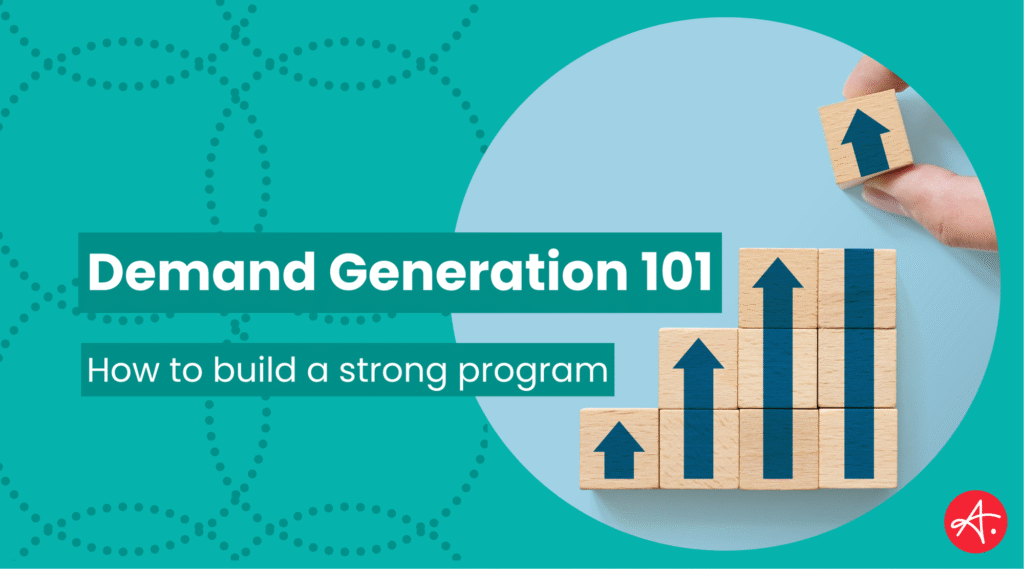Demand Generation 101: Build a foundation for a strong program

Small and growing businesses are often laser-focused on demand generation. They want more “at-bats,” or opportunities, for their sales team. But demand generation isn’t as simple as putting your company’s message out into the marketplace. Demand generation is the process of creating brand awareness with relevant, targeted stakeholder groups (i.e., prospects) and then building on this awareness by nurturing prospects to create new revenue opportunities.
Unfortunately, demand generation causes more tension and frustration than perhaps any other marketing discipline. Too often, this tension is the result of misaligned and unrealistic expectations. Business leaders often don’t understand what they need to do to shape a strong demand generation program. Simultaneously, technology providers and marketing agencies overpromise the quantity or quality of leads they can generate — and the speed at which they can generate them.
The reality is that demand generation is a multifaceted process and a discipline that can take growing businesses years to develop and refine. There’s no magic button or quick switch that will generate the qualified leads your business needs — no matter how many promises an agency or service provider makes.
Businesses that answer these five foundational questions can steer their demand generation program toward a more strategic path that will establish long-term results.
5 Fundamental Demand Generation Questions to Answer
Whom are we targeting, and what do we want them to do?
A strong demand generation program begins long before a business identifies the tactics and approach it will use to attract, nurture, and convert leads. Your company first needs a solid understanding of its ideal customers, which it will target with its demand gen efforts, and what actions it wants each target to take.
Many businesses struggle to choose which audiences to invest in and focus on. But this decision is one of the most critical and strategic ones your business will make. No company has unlimited resources, and pointing your resources in too many directions will dilute your demand generation efforts and lead to lackluster results. Ben Theis, CEO of SKOL Marketing, an Authentic Ally Network™ provider, recommends the following exercise to narrow and prioritize your audiences:
“Identify the top five to 10 companies that your business wants to work with. Using that list, prioritize them based on which would drive the greatest impact on your business. This exercise helps businesses get an idea of who their highest-value prospects are and which company types, industries, job titles, and business sizes it would make the most sense to target with demand generation.”
Ben Theis
CEO | SKOL Marketing
Once your business knows the audiences it will target, it needs to identify what action it wants each target audience to take. Of course, companies are typically driving toward a sale. But in B2B environments, many steps need to happen before a deal closes. Consider all of the different paths a target audience may take when learning about and evaluating your products or services, and identify actions you want them to take along the way.
These actions could be anything from visiting your website, signing up for your e-newsletter, downloading a white paper, attending an event, submitting a contact form, or signing up for a demo. After you identify the desired actions, you know what behaviors you’re trying to influence with demand generation and what marketing activities you need to invest in to support them.
How can we use content to fuel awareness and conversion?
Content is the foundation of a strong demand generation program. When done well to support the needs of your target audiences, content is a form of owned media that will deliver day after day and year after year. Leveraging different content formats can fuel both awareness and conversion. Ruth Glaser, an Authentic Fractional CMO™, says of content:
“When you create good content, you invest in an annuity that will enable you to run campaigns and leverage different marketing tactics that will generate the high-quality leads you’re looking for. You may be chugging along for a few years — investing in good content — and then you finally get that traction and ‘hockey stick growth.’ Your growth accelerates really quickly.”
Ruth Glaser
Authentic Fractional CMO™ | Authentic
Ben Theis of SKOL Marketing adds:
“Lay the foundation for your whole demand generation strategy with content and owned media, and build on top of that with paid media. Owned media is essentially like owning and investing in your own real estate instead of renting space from a search engine like Google or Bing or a social media platform like Facebook or LinkedIn. Content is a long-term investment. The objective is to position yourself as an industry expert, and from an online perspective, to convince Google and other search engines that you are a reputable expert on the subject matter so that you begin to show up when prospects are searching.”
Ben Theis
CEO | SKOL Marketing
On-site website content like blog posts, pillar pages, and videos drive brand awareness, while content that requires users to complete forms or register, like white papers, eBooks, guides, webinars, and events, provides conversion opportunities.
How much are we going to invest, and what are realistic ROI expectations?
Business leaders often want us to tell them exactly how much they should spend on marketing or demand generation programs. Sometimes they claim to have an unlimited marketing budget — so long as we can guarantee a certain return on investment (ROI). Unfortunately, it’s not this simple.
There’s no silver bullet budget marketing framework that says if you invest $X, you’ll get $Y in ROI, and it’ll take you Z number of days or months. (If someone promises you this, be skeptical.) There are too many unique business factors, including growth expectations, industry and business stage, and business model (e.g., B2B vs. B2C), that impact how much your company should invest and how much it could expect in return.
Ryan Ruud, founder and CEO of Lake One, an Authentic Ally Network™ provider, shared how his company typically approaches the ROI discussion with clients:
“Early in our client engagements, we like to have discussions about KPIs that get us as close to revenue as possible. We want to help you get the most accurate ROI calculation — not one based on vanity metrics, like clicks, views, and impressions, that mean little to your bottom line. These ROI calculations typically start with best-guess estimates when companies don’t have benchmarks to work from. It could be as simple as: A prospect came to our website via a marketing campaign that cost $X and eventually converted to $Y revenue. In this case, calculating the ROI is basic arithmetic.”
Ryan Ruud
Founder & CEO | Lake One
How will we determine lead quality and conversion expectations?
It’s one thing to generate leads, and it’s another to generate high-quality leads that convert into opportunities that convert into sales. Effective demand generation takes time. Prospects often need to encounter a brand 7-15 times before they become aware of it. And awareness is only the first step of the process.
After building awareness, your marketing team needs to engage prospects and build their trust by proving your products or services are relevant and valuable to them (typically through some form of targeted content). Then, your team has to evaluate if the prospect is even a good fit (i.e., qualified) for the business. Even after a lead is qualified as a viable opportunity, the B2B sales process can be slow and complex, often involving many internal stakeholders.
Ryan Ruud of Lake One added to this sentiment:
“There’s a personality trait that is key and foundational to any revenue team, and that’s patience. Demand generation is not a switch that gets flipped on, and then all of a sudden, your sales problems are solved overnight. It takes a thoughtful strategy and time. The timeline for the conversion funnel often varies across businesses and channels.”
Ryan Ruud
Founder & CEO | Lake One
Keep the following tips in mind when considering lead quality and conversion expectations:
- Identify what marketing activities a prospect needs to go through to be effectively nurtured.
- Align internally on what constitutes a qualified lead and what the value of each lead is to the business.
- Develop a lead hand-off and follow-up process that outlines when marketing should pass a lead to sales and what the sales team is expected to do when they get the qualified lead.
- Create a feedback loop between sales and marketing to continually refine the demand generation process and lead qualification criteria.
How can we align demand generation with customer retention and expansion?
You can use the content you develop for your demand generation programs for more than generating new leads or nurturing prospects. It can also support customer retention and expansion initiatives. When your business has strong working relationships between sales, marketing, and customer service, each team can share insights they’ve learned in their respective roles. These insights can inform future marketing, sales, and customer programs and spark ideas for leveraging the content across teams.
For example, your marketing team might host a webinar about a topic they learned from customer service that customers ask a lot about. Not only can your business use this webinar to drive interest and generate new leads because the topic is relevant to prospects, but marketing can also share the recording and slide deck with sales and customer service. Sales can use the recording as a sales enablement tool to nudge their assigned contacts further down the sales funnel. The customer service team can share the recording when an existing customer runs into the same challenge that sparked the webinar idea. Getting creative about repurposing content enables sales and customer service to offer greater value to their accounts and helps your marketing investments go further.
Demand Generation isn’t easy.
Demand generation isn’t easy. It requires strategic planning, smart investments, and thoughtful execution. The sooner your business starts building toward a strong program, the sooner you will reap the long-term benefits. If your business is overwhelmed by building and implementing its demand generation program, we’d love to discuss how one Authentic’s marketing leaders can support you. Our senior marketers and Authentic Growth Methodology™ helps growing companies make marketing a sustained, strategic, sales-aligned aspect of their business.
